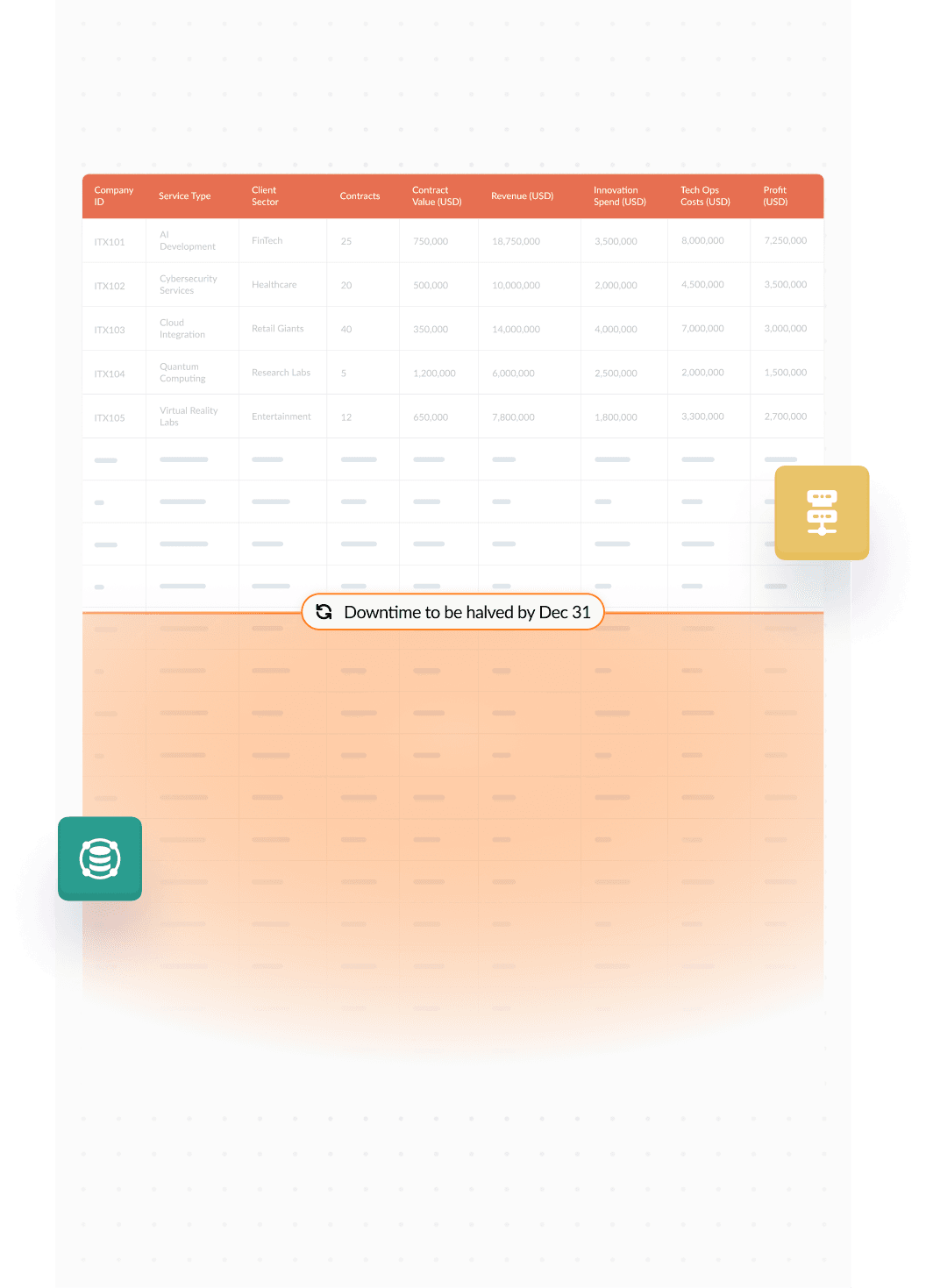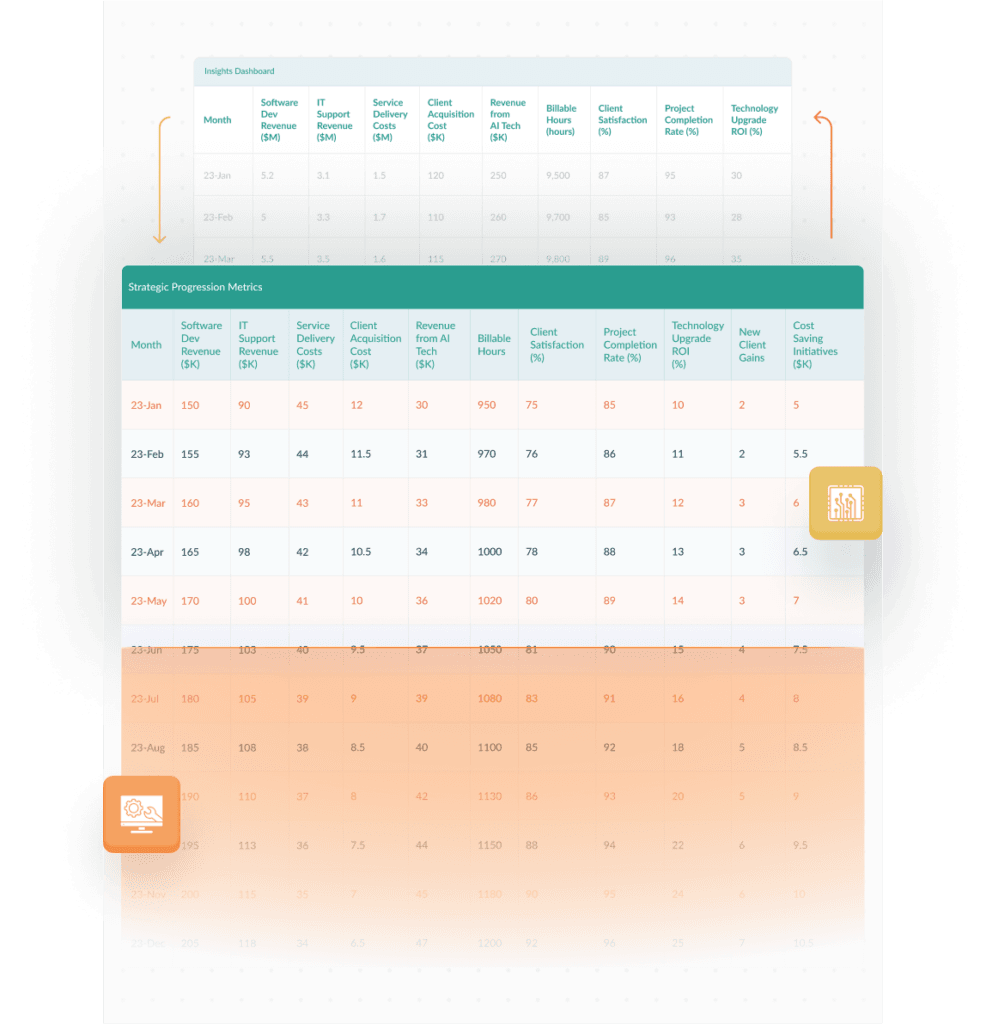Information Technology
Software Development, IT Support, and Technology Services

Financial & Capital Analytics
Software Development Revenue Models: Analyze revenue streams from software licensing, subscriptions, and custom development projects. Assess the impact of pricing models such as per-user, per-feature, and tiered subscriptions on profitability
IT Support Contract Profitability: Evaluate the financial performance of IT support contracts, focusing on contract length, service level agreements (SLAs), and cost of service delivery. Identify high-margin contracts and areas for cost optimization
Technology Service Growth Metrics: Scrutinize key financial metrics for technology services, including client acquisition costs, average project value, and recurring revenue percentages
Client and Project Portfolio Management: Optimize the portfolio of projects and clients by analyzing profitability, risk, and strategic value. Identify underperforming projects or clients for reallocation of resources or renegotiation of terms
Resource Utilization Rates: Balance human and technological resources to maximize billable hours and minimize downtime. Evaluate the financial impact of resource allocation decisions on project profitability and client satisfaction
Emerging Technology Adoption Trends: Conduct research into the adoption rates of emerging technologies like AI, blockchain, and IoT. Analyze market demand and potential revenue streams from these technologies
Competitive Benchmarking in IT Services: Engage in competitive analysis to benchmark pricing, service offerings, and financial performance against leading industry players. Identify gaps and opportunities for differentiation
Cash Flow Forecasting for Tech Projects: Develop financial models that forecast cash flows for large technology projects. Include variables such as milestone payments, project delays, and cost overruns
ROI Analysis for Technology Investments: Create models to calculate the return on investment for technology upgrades and new service offerings. Factor in both direct financial returns and indirect benefits such as improved efficiency or customer satisfaction
Funding Strategies for Tech Startups and Expansions: Identify the most effective funding strategies for technology startups or expansion projects. Consider options like venture capital, angel investing, and public funding
Financial Risk Management for IT Firms: Develop strategies to manage financial risks specific to IT businesses, such as project overruns, client concentration risks, and currency fluctuations in global projects
Service Delivery Cost Variance: Monitor and manage variances in the cost of delivering IT services. Analyze discrepancies between estimated and actual costs to identify inefficiencies and adjust pricing or processes
Revenue Variance Analysis: Track variances between forecasted and actual revenues from different revenue streams. Adjust sales strategies and operational plans based on variance analysis findings
Technology Lifecycle Risk: Evaluate the risks associated with the rapid obsolescence of technology. Develop strategies to mitigate financial exposure from investments in quickly aging technologies
Client Dependency Risks: Assess financial risks stemming from overreliance on key clients. Develop diversification strategies to spread risk and enhance financial stability
Strategic Acquisitions in IT: Analyze potential M&A opportunities to acquire complementary technologies or expand market reach. Evaluate financial synergies, integration challenges, and potential for innovation enhancement
Divestitures of Non-Core Business Units: Assess the strategic and financial implications of divesting non-core business units. Model the potential impact on the company’s financial health and focus
Process Mining
Acquire data from software development cycles, IT support logs, and technology service reports
Standardize this technical data to eliminate errors and create a unified basis for process analysis
Outline IT processes from development to deployment and support, identifying key stages and interaction points
Investigate the match between actual IT operations and the intended technological frameworks and service standards
Upgrade software development methodologies, enhance support protocols, and streamline service delivery based on process findings


Business Intelligence
Summarize project completion rates, bug resolution times, and customer satisfaction metrics to evaluate IT service performance
Diagnose issues in software development cycles or customer support incidents by analyzing process flows, team communication, and technology tools used
Forecast future technology needs or potential system vulnerabilities using data from past IT projects and emerging technology trends
Recommend specific technology upgrades or process improvements to enhance efficiency and security based on the outcomes of predictive models
Combine data from user interactions, software performance, and industry benchmarks to infer best practices for software development and IT management
Streamlining
Map out the software development lifecycle, IT support processes, and service delivery frameworks. Identify inefficiencies like repetitive coding tasks, slow bug fix implementations, or cumbersome support ticket handling
Integrate tools for continuous integration and continuous delivery (CI/CD) in software development, and use automated help desk solutions for handling routine IT support queries
Use metrics such as development cycle times, system uptime, support ticket resolution times, and customer satisfaction levels to monitor and optimize IT operations
Merge similar technology services or support functions to centralize expertise and reduce redundancies across different departments or service areas
Develop standard coding practices, documentation requirements, and support protocols to ensure quality and streamline operations across various IT projects and services
Implement regular feedback sessions with end-users and clients, plus sprint retrospectives within teams to continuously improve software solutions and IT services
Evaluate the impact of streamlining efforts on productivity, cost savings, and customer or end-user satisfaction. Adjust IT strategies to align better with business goals and user needs

